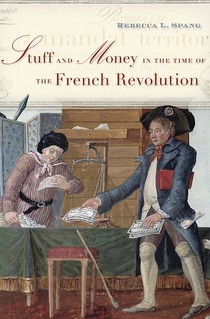
PREV ARTICLE
NEXT ARTICLE
FULL ISSUE
PREV FULL ISSUE
NEW BOOK: STUFF AND MONEYNew subscriber Rebecca L. Spang published a book in 2015 that we missed at the time (the paperback came out in 2017). Spang is Professor of History and Director of the Center for Eighteenth-Century Studies at Indiana University. Here's the description from the publisher's website, Harvard University Press. -Editor
But Spang’s book is also a new history of the French Revolution, one in which radicalization was driven by an ever-widening gap between political ideals and the realities of daily life. Money played a critical role in creating this gulf. Wed to the idea that liberty required economic deregulation as well as political freedom, revolutionary legislators extended the notion of free trade to include “freedom of money.” The consequences were disastrous. Backed neither by the weight of tradition nor by the state that issued them, the assignats could not be a functioning currency. Ever reluctant to interfere in the workings of the market, lawmakers thought changes to the material form of the assignats should suffice to enhance their credibility. Their hopes were disappointed, and the Revolution spiraled out of control. Stuff and Money in the Time of the French Revolution restores economics, in the broadest sense, to its rightful place at the heart of the Revolution and hence to that of modern politics.
For more information, or to order, see:
Here's a review by Patrice Higonnet from The Times Literary Supplement. -Editor As Rebecca Spang explains, in the Marxist interpretation of the course of the French Revolution, Paris artisans with a social grievance teamed up with ideologized left-bourgeois Jacobins against rightbourgeois Girondins in 1793, forming Robespierre’s “Mountain”. However, the Mountain’s “desire for power and the working-class hunger for bread were made to coincide only briefly and through force”. In the 1980s, new interpretations emerged. Revisionists argued that the plebs did indeed despise the vocabulary of commerce and economic individualism. But they also insisted that the not-really-bourgeois deputies like Robespierre disdained it too. Thus all ideological roads led to the guillotine. In Stuff and Money in the Time of the French Revolution, Spang disagrees categorically with both views. For her, the issues surrounding Revolutionary paper money, or assignats, were neither simply social nor ideological. They were simultaneously social and political. In fact, the assignat, she deftly shows, was meant to be both state-sponsored, i.e. national, and natural, i.e. worth something that was very real. Indeed, in 1790–91, the bourgeois revolutionaries often argued that the assignats were not a paper money at all because the new elegantly engraved notes would be a kind of short-term interest-yielding government bond. Citizens would use these “notes” to buy confiscated Church land; and the notes would then be burnt. Not paper money, then, but a kind of Quantitative Easing which would affect neither wages nor price. For Spang, these “notes” changed everything: “the prostitute whose client had only large-denomination assignats [and] the beggar surprised to receive paper alms” had to think again. As did everyone else: in these moments of socio-political intercourse, neither class war nor Rousseau’s general will was really on anybody’s mind. Food in Paris was always plentiful: the problem was that peasants, landlords and shopkeepers gradually refused to trade food for paper money. Context or “stuff” was the key, as in the “stuff” of Prospero’s dreams. For a while, all was well. Jacobins assumed that the discourse of “commerce” and “civic virtue” were compatible. But in the end, between 9th Thermidor (July 27, 1794) and their demonetization in February 1796, the assignats inexorably lost all of their remaining value. This is a quite brilliant, assertive book. For Spang, all historians (“pace Furet” and “pace Soboul”) were wrong, as are – or were – culturally blind, apolitical economists; all Jacobins; some prostitutes and beggars, and, also, Edmund Burke, who explained in 1791 that “the utter destruction of assignats, and . . . the restoration of order, are one”. Restoring ancient world orders, as we know, usually doesn’t work.
To read the complete article, see:
Wayne Homren, Editor The Numismatic Bibliomania Society is a non-profit organization promoting numismatic literature. See our web site at coinbooks.org. To submit items for publication in The E-Sylum, write to the Editor at this address: whomren@gmail.com To subscribe go to: https://my.binhost.com/lists/listinfo/esylum All Rights Reserved. NBS Home Page Contact the NBS webmaster 
|
